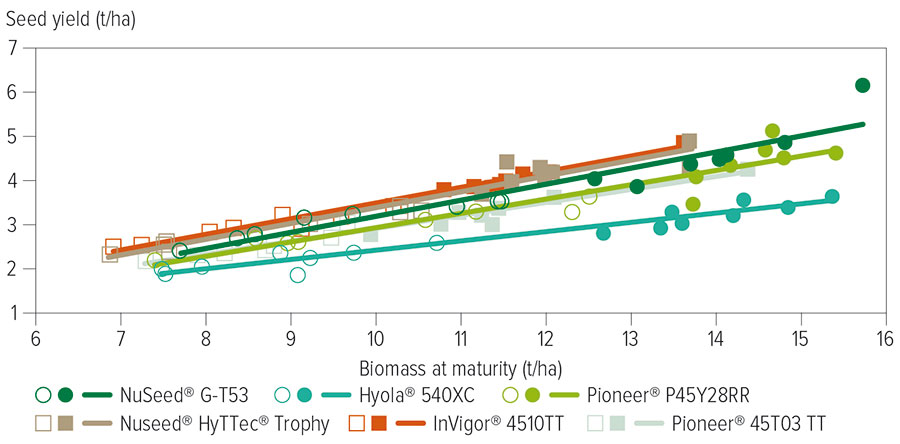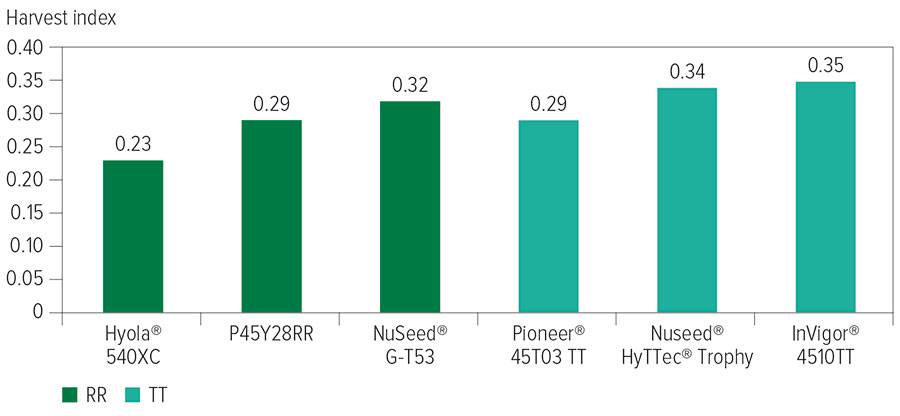Crop yield depends on its total biomass production and how efficiently it converts this growth into yield – termed the harvest index – but for canola in high-rainfall zones it is a balance of risks and rewards
While high canola biomass generally leads to improved yield, high biomass production can also present challenges – higher input costs and associated financial risk, harvesting difficulties associated with tall crops, high stubble loads and in-season water use, and an increased Sclerotinia risk.
These challenges promote vigorous discussion among canola growers pursuing the optimal strategy that balances risk against reward in the relationship between biomass and harvest index.
How these relationships can be managed to achieve greater returns is the perennial question.
Previous research has shown that canola productivity in the high-rainfall zone (HRZ, 450-millimetre-plus annual rainfall) is dependent on biomass accumulation, with high yields coming from high-biomass crops despite an associated reduction in harvest index.
Hybrid canola, in particular, accumulates high biomass at a reduced harvest index to produce a high yield, which is rarely matched by the lower biomass open-pollinated cultivars (despite their higher harvest index).
With GRDC investment, Western Australian Department of Primary Industries and Regional Development and CSIRO researchers are investigating ways to manipulate the biomass and harvest index relationship while maintaining high yields to reduce the trade-offs associated with high-biomass canola crops.
Trials in the Kojonup-Boyup Brook district and at Esperance tested ways to manipulate canola canopy size using a combination of genetics and agronomy.
These included different nutrition levels (high versus very high nitrogen and sulfur – 150 kilograms of nitrogen per hectare and 12kg sulfur/ha versus 300kg nitrogen/ha and 44kg sulfur/ha), in combination with plant density (20 and 40 plants per square metre), grazing (grazed before flowering versus ungrazed) and plant growth regulators in high-vigour Roundup Ready® (RR) hybrids versus lower-vigour triazine-tolerant (TT) hybrids.
These treatments had a huge impact on plant height (119 to 176 centimetres), biomass (8.2 to 15.7 tonnes/ha) and yield (1.9 to 6.2t/ha).
The data shows that while biomass and canopy size are strongly influenced by agronomy, it is much harder to move harvest index, which is stable in most cultivars (see slopes in Figure 1).
Figure 1: Changes along the yield-biomass progression at Qualeup, WA, in 2020. Most cultivars had stable harvest index with similar yield-biomass slopes, while some got worse as biomass increased. (Grazed treatments: empty markers; ungrazed treatments: full markers. RR canola varieties are represented by circles, TT types by triangles.) (P<0.001, LSD=0.01)

Source: CSIRO
This is important because yield differences are driven by harvest index, while harvest index itself is dominated by genetics and its interaction with agronomy. Thus, harvest index tends to be lower in RR than TT canola (Figure 2), with some additional important differences within both groups
Figure 2: Average cultivar harvest index across all agronomy treatments at Qualeup, WA, in 2020 with cultivars grouped by herbicide resistance class.
 Source: CSIRO
Source: CSIRO
In another round of experiments, canola canopy growth was further manipulated with plant growth regulators (PGRs). While PGR application reduced canopy height in both Esperance and Kojonup trials, the effects on yield, biomass and harvest index were inconsistent. More work was undertaken at both locations in 2021 to better understand the role and modes of action of PGRs.
The 2020 results suggest that varieties such as NuSeed® G-T53, InVigor® 4510TT or NuSeed® HyTTec® Trophy, which have a stable harvest index, showed no harvest index trade-offs across their agronomic treatments. They will not produce excessive vegetative biomass as they increase their input levels.
This indicates that growers can use whatever input level they are comfortable with, knowing their canola will produce its genetic potential at that input level (assuming they are growing stable, high-harvest-index varieties).
2021 was ideal for the team to conduct more experiments to unravel crop biomass interactions due to the long, relatively high-rainfall season in both locations.
In-season height measurements showed the treatments had a big impact on canopy size but, at the time of writing, harvest had not yet occurred.
More information: Dr Jens Berger, jens.berger@csiro.au

























































